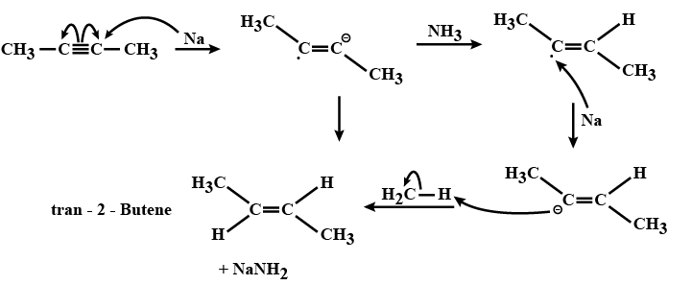Question
Question: What happens when but-2-yne is treated with Na in liquid ammonia? A.Cis-2-butene is formed B.Tra...
What happens when but-2-yne is treated with Na in liquid ammonia?
A.Cis-2-butene is formed
B.Trans-2-butene is formed
C.n-butane is the major product
D.It rearranges to but-1-yne
E.There is no reaction
Solution
Sodium in liquid ammonia reduces alkynes to alkenes. The reaction is called Birch reduction. In other words, it hydrogenates the alkynes to form alkenes.
Complete step by step answer:
The reduction of alkynes to alkenes is done with the help of sodium in liquid ammonia. This catalyst readily gives the trans-2-Butene (E-2-Butene). This reaction is known as Birch reduction. In order to obtain cis-2-Butene, Lindlar catalyst can be employed. Lindlar catalyst is a combination of Palladium, lead acetate and quinoline with hydrogen gas being pumped at high pressure.
But-2-yne when treated with sodium in liquid ammonia gives trans-2-butene.

The reaction of alkyne with sodium in liquid ammonia produces sodamide in the process converting alkynes to alkenes.
Mechanism of Birch Reduction:
-Sodium in liquid ammonia produces solvated electrons.
-The attack of solvated electrons forms a radical anion.
-Now, protonation of the radical anion takes place.
-The reduction of radicals to an anion by electrons occurs.
-Now through protonation of the anion by alcohol, desired alkene is formed.

So, the correct option is B.
Note:
Instead of sodium metal, even lithium (Li) metal can be used. Keep in mind sodium amide or with liq. Ammonia is not a Birch reduction. Since sodamide is a strong base and not a reducing agent.
